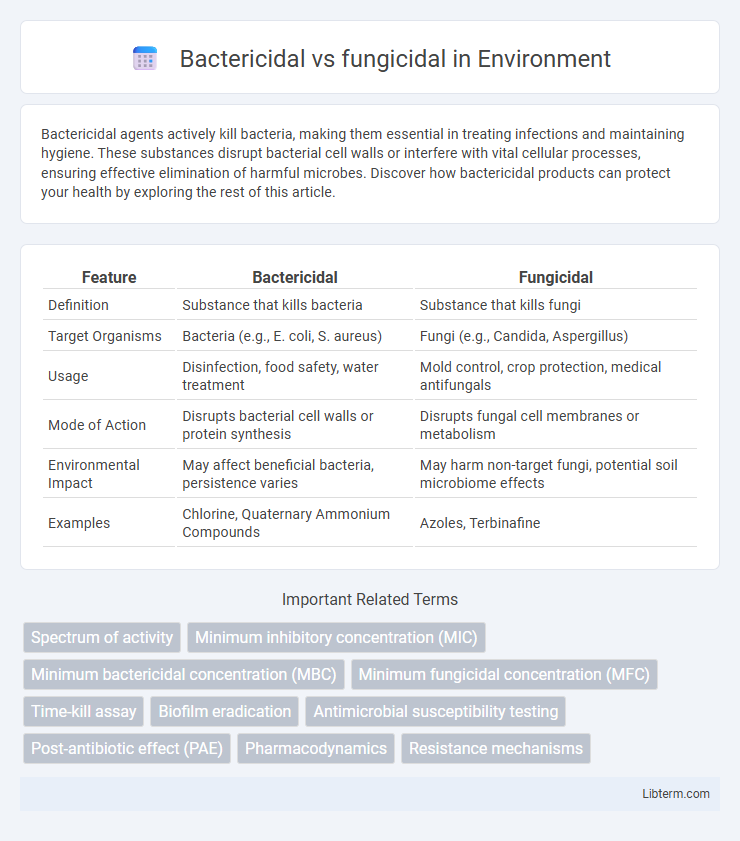Bactericidal agents actively kill bacteria, making them essential in treating infections and maintaining hygiene. These substances disrupt bacterial cell walls or interfere with vital cellular processes, ensuring effective elimination of harmful microbes. Discover how bactericidal products can protect your health by exploring the rest of this article.
Table of Comparison
| Feature | Bactericidal | Fungicidal |
|---|---|---|
| Definition | Substance that kills bacteria | Substance that kills fungi |
| Target Organisms | Bacteria (e.g., E. coli, S. aureus) | Fungi (e.g., Candida, Aspergillus) |
| Usage | Disinfection, food safety, water treatment | Mold control, crop protection, medical antifungals |
| Mode of Action | Disrupts bacterial cell walls or protein synthesis | Disrupts fungal cell membranes or metabolism |
| Environmental Impact | May affect beneficial bacteria, persistence varies | May harm non-target fungi, potential soil microbiome effects |
| Examples | Chlorine, Quaternary Ammonium Compounds | Azoles, Terbinafine |
Introduction to Bactericidal and Fungicidal Agents
Bactericidal agents actively kill bacteria by disrupting cell wall synthesis, protein production, or DNA replication, effectively eliminating bacterial infections. Fungicidal agents target fungal cells by compromising the integrity of the fungal cell membrane or interfering with essential metabolic processes, leading to fungal cell death. Both types of agents are critical in antimicrobial therapy, with bactericidal compounds used to treat bacterial infections and fungicidal compounds essential for managing fungal diseases.
Defining Bactericidal: How It Works
Bactericidal agents kill bacteria by disrupting critical cellular functions such as cell wall synthesis, protein production, or DNA replication, leading to bacterial cell death. These agents target specific bacterial structures or metabolic pathways, causing irreversible damage that prevents bacterial growth and replication. Common examples include antibiotics like penicillin and ciprofloxacin, which directly eliminate bacterial populations rather than merely inhibiting their growth.
Understanding Fungicidal Mechanisms
Fungicidal agents destroy fungal cells by targeting critical components such as the cell membrane and cell wall, often disrupting ergosterol synthesis or b-glucan formation. These mechanisms induce fungal cell death through increased membrane permeability or inhibited cell wall integrity, effectively eliminating pathogenic fungi. Understanding these specific biochemical targets is crucial for developing potent antifungal treatments and minimizing resistance.
Key Differences Between Bactericidal and Fungicidal Agents
Bactericidal agents specifically target and kill bacteria by disrupting their cell walls or intracellular functions, while fungicidal agents eliminate fungi by damaging fungal cell membranes or inhibiting critical enzymes. The chemical structure and mode of action differ significantly, with bactericides often containing agents like penicillins and quinolones, and fungicides including azoles and echinocandins. Resistance mechanisms also vary, as bacteria develop antibiotic resistance through genetic mutations, whereas fungi often adapt via modifications in ergosterol synthesis or efflux pump activity.
Common Applications of Bactericidal Products
Bactericidal products are widely used in healthcare settings to eliminate bacterial infections and prevent contamination on medical instruments, surfaces, and skin. These agents are essential in food processing industries for sanitizing equipment and ensuring the safety of consumable products. Household cleaning products, such as disinfectants and antibacterial sprays, also rely on bactericidal compounds to reduce bacterial populations and maintain hygiene.
Popular Uses of Fungicidal Treatments
Fungicidal treatments are widely used in agriculture to protect crops such as grapes, apples, and cereals from fungal diseases like powdery mildew, rust, and blight, ensuring higher yields and quality produce. In healthcare, fungicidal agents treat fungal infections on skin and nails, including athlete's foot and ringworm, offering effective eradication of pathogens. Unlike bactericidal treatments that target bacterial infections, fungicidal products are specifically formulated to disrupt fungal cell membranes and inhibit spore germination, making them essential for fungal disease management across various industries.
Efficacy Factors: Choosing the Right Agent
Efficacy factors in choosing between bactericidal and fungicidal agents hinge on microbial target, concentration, contact time, and environmental conditions. Bactericidal agents effectively eliminate bacteria by disrupting cell walls or metabolic processes, while fungicidal agents target fungal cell membranes and inhibit spore germination. Selecting the appropriate agent depends on pathogen susceptibility, presence of biofilms, and potential resistance mechanisms to ensure maximum antimicrobial effectiveness.
Safety and Side Effects: Bactericidal vs Fungicidal
Bactericidal agents target bacterial cells, often causing fewer side effects due to their specificity, but they can disrupt normal bacterial flora, leading to issues like gastrointestinal upset or antibiotic resistance. Fungicidal treatments eliminate fungal pathogens aggressively, which may increase the risk of toxicity and allergic reactions, especially with systemic administration. Careful selection based on the infection type and patient health is essential to minimize adverse effects and ensure safety during treatment.
Environmental Impact of Antimicrobial Agents
Bactericidal agents target and kill bacteria, while fungicidal agents specifically eliminate fungi, each with distinct mechanisms affecting microbial populations in ecosystems. The environmental impact of these antimicrobial agents depends on their persistence, toxicity, and potential to disrupt microbial communities essential for soil fertility and water quality. Overuse of bactericidal and fungicidal substances can lead to antimicrobial resistance and harm non-target organisms, emphasizing the need for sustainable application practices and eco-friendly formulations.
Future Trends in Bactericidal and Fungicidal Research
Future trends in bactericidal and fungicidal research emphasize the development of nanotechnology-based agents and bio-inspired compounds to enhance antimicrobial efficacy while minimizing resistance. Advances in genomic and proteomic tools enable precise targeting of bacterial and fungal pathogens, accelerating the discovery of novel antimicrobial mechanisms. Sustainable and environmentally friendly formulations are increasingly prioritized, integrating green chemistry principles to reduce ecological impact during pathogen control.
Bactericidal Infographic

 libterm.com
libterm.com